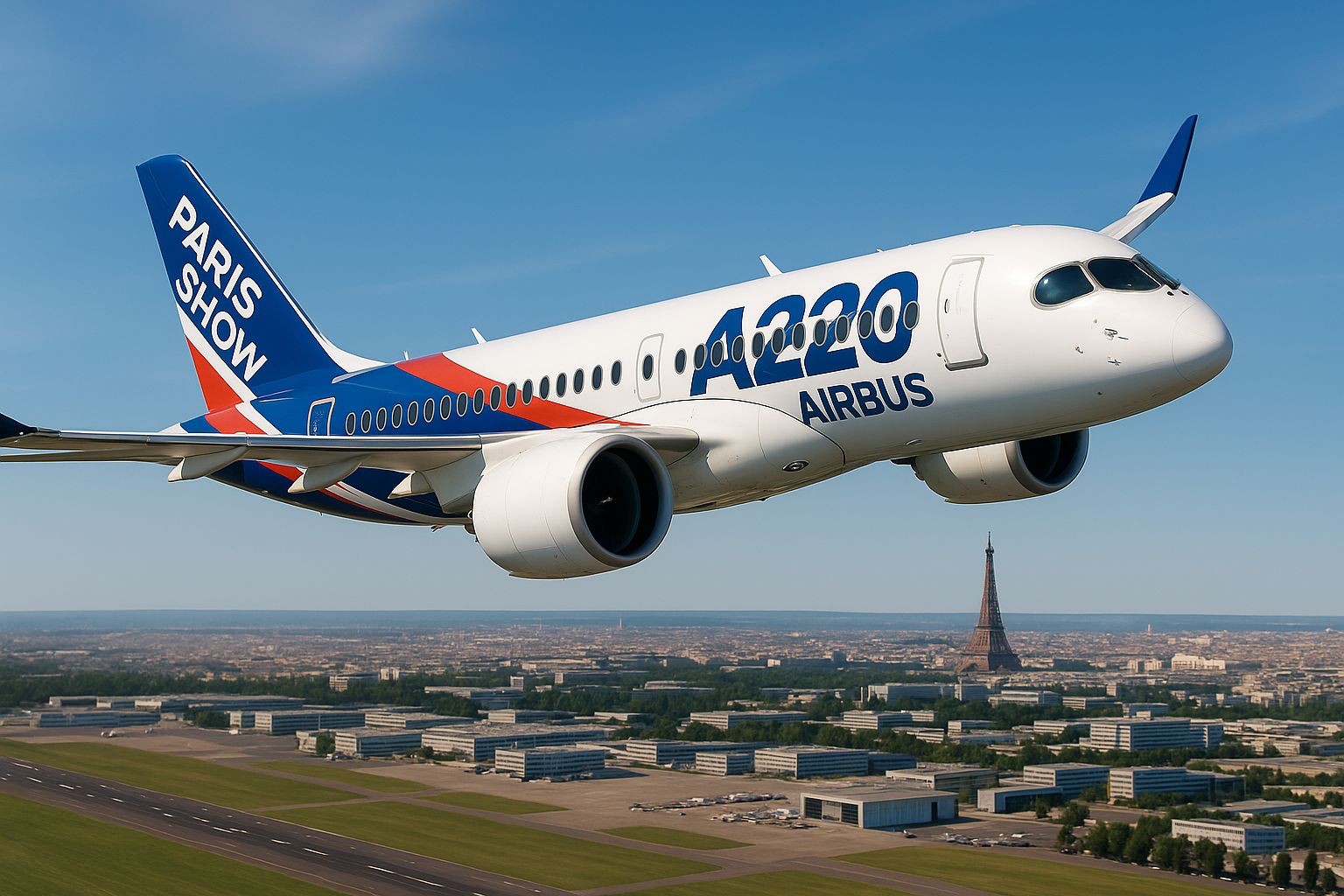In a rapidly evolving global aviation market, could recent Airbus A220 deals reshape fleet strategies for major airlines?
Recent moves by AirAsia and Royal Air Maroc suggest precisely that, signalling significant new wins for Airbus and potential shifts in the aerospace landscape.
Royal Air Maroc Eyes Historic Airbus Order
Royal Air Maroc (RAM), Morocco’s national airline, which has traditionally been a strong Boeing partner, is making headlines as it reportedly considers adding up to 20 Airbus A220 aircraft to its fleet. According to detailed reports from FlightGlobal and Reuters, the deal would mark Airbus’s first significant order with RAM in nearly a quarter of a century.
The airline’s fleet renewal program primarily features Boeing’s long-haul 787 Dreamliner and medium-haul 737 MAX. However, the inclusion of Airbus’s smaller, fuel-efficient A220 would strategically diversify RAM’s offerings, particularly valuable as Morocco prepares to co-host the FIFA World Cup in 2030. With increased tourism and demand for regional connectivity, RAM sees the A220’s performance and efficiency as vital.
Sources indicate that the Moroccan flag carrier is drawn to the A220’s fuel efficiency, which offers up to 20% lower fuel burn per seat compared to previous-generation aircraft, significantly reducing operating costs and carbon footprint—a critical factor in today’s environmentally conscious aviation market.
Such Airbus A220 deals could also serve as a strategic turning point for RAM, boosting Airbus’s presence in previously Boeing-dominated markets.
AirAsia Nears Landmark 100 A220 Airbus Deal
Parallel to RAM’s developments, Southeast Asia’s budget giant AirAsia is reportedly close to signing an unprecedented order for at least 100 Airbus jets, prominently featuring the Airbus A220 deals. This potential mega-deal, as Reuters highlights, could be formally announced at the upcoming Paris Air Show, one of the aerospace industry’s premier events.
AirAsia, already heavily invested in Airbus’s A320 family for its extensive regional network, views the smaller, more economical A220 as the ideal aircraft to enhance regional operations. The airline’s operations often involve short-haul flights, where efficiency and turnaround speed directly impact profitability. Analysts suggest the A220’s ability to operate economically on shorter, thinner routes makes it an excellent complement to AirAsia’s larger A320 family fleet.
Moreover, with passenger traffic rapidly recovering across the Asia-Pacific region post-pandemic, airlines are aggressively positioning themselves for a more sustainable, fuel-efficient future. The A220, with its cutting-edge aerodynamics, Pratt & Whitney geared turbofan engines, and innovative cabin designs, meets this precise demand.
Why the Airbus A220?
The Airbus A220 has quickly gained traction globally since its introduction. Originally developed by Bombardier as the CSeries, Airbus took a controlling stake in the program in 2018. This aircraft uniquely blends comfort, efficiency, and operational flexibility, appealing to airlines across diverse markets.
As recently reported by Fliegerfaust, despite its growing popularity, the A220 program has faced production hurdles, including unexpected incidents at its Mirabel facility, which have affected monthly deliveries. Such operational challenges emphasize the complexity Airbus faces in ramping up production to meet growing global demand.
Market Impact of Airbus A220 Deals
These potential orders collectively represent significant validation for the A220 program, especially as Airbus continues competing fiercely with Embraer’s E2 series regional jets. Securing large-scale orders from carriers like AirAsia and established airlines like Royal Air Maroc bolsters Airbus’s competitive positioning, particularly in regions traditionally dominated by Boeing or regional jet manufacturers.
The emerging success of the A220 reflects a broader industry shift towards efficiency and sustainability. Airlines are increasingly pressured to manage environmental footprints and operational efficiency simultaneously—an aspect where the A220 particularly excels.
Challenges Ahead?
While optimism surrounds these developments, questions remain. Can Airbus smoothly scale production to meet potentially vast new demands without compromising existing orders? Further, will the market fully embrace the smaller A220’s operational advantages compared to larger, more established single-aisle jets like the Airbus A320 or Boeing’s 737 MAX?
Moreover, as highlighted by Fliegerfaust’s deep dive into the potential A220-500, the challenges of stretching the aircraft without significant wing redesign raise essential questions about the future versatility and market potential of the A220 platform.
As these deals unfold, Airbus faces heightened pressure to demonstrate robust operational and logistical strategies to ensure seamless delivery and fleet integration for airlines undertaking substantial fleet restructuring.
Conclusion: A Pivotal Moment?
The Airbus A220 stands at a pivotal junction, with Royal Air Maroc and AirAsia poised to be significant adopters. These developments could redefine both airlines’ fleet strategies and reinforce Airbus’s position in competitive markets.
Yet, crucial questions linger. Will these new orders drive a significant industry shift towards smaller, efficiency-focused aircraft, or will operational realities temper enthusiasm? Will Airbus successfully accelerate A220 production?
Ultimately, airlines must thoroughly evaluate whether the Airbus A220 will sustainably fulfill their long-term strategic and operational needs. Could the Airbus A220 indeed become aviation’s new standard bearer?
As aviation enthusiasts and industry professionals closely follow these developments, airlines must carefully consider if now is the right time to heavily invest in this promising aircraft. This includes evaluating whether all issues with its Pratt & Whitney engines will be fully resolved before delivery.
Will the A220’s efficiency and adaptability indeed become the key differentiator Airbus anticipates?


C’est certain qu’en augmentant la cadence de production comme elle le fait présentement Airbus améliore ses chances d’engranger de nouvelles commandes. Il revient maintenant à Pratt & Whitney d’améliorer la fiabilité de ses moteurs.
This excerpt is from an upcoming book I am writing, detailing the complete story of the A220/CSeries:
===
Addressing Supply Chain Issues – and China, India
Ongoing global supply chain issues have presented significant challenges, leading to delays in various programs across the aerospace industry, including those of major manufacturers like Boeing and Airbus, as well as the A220 program.
Responding to this, Airbus undertook initiatives to foster quality and punctuality in deliveries through renegotiated supplier agreements, aiming to build a more robust and competitive supply chain.
Bombardier’s initial collaboration with Shenyang Aircraft Corporation (SAC) in China saw a pronounced on-site presence, with up to 52 team members stationed at SAC as of 2018. This heavy presence was deemed essential for closely monitoring, guiding, and ensuring the quality and timeliness of SAC’s work.
The handover to Airbus brought with it new managerial philosophies and expectations. Initially, Airbus envisaged a leaner on-site approach, with their representatives expressing a desire to have no more than 10 personnel stationed at SAC, emphasizing the principle that suppliers should manage their work independently.
However, by February 2023, the situation evolved quite differently. There were as many as 59 Airbus team members making up the Airbus ‘Plateau’ multi-function on-site team at SAC.
This increase underscores a recognition by Airbus of the challenges Bombardier faced and the realization that intensive oversight was crucial for SAC’s efficiency and quality control. This on-the-ground presence highlighted a shared understanding between the two aviation giants: while SAC has great potential as a partner, realizing that potential requires direct, hands-on management.
Navigating Towards Enhanced Production: Airbus’ Strategic Move
In anticipation of ramping production rates, Airbus astutely negotiated modifications to its contract with SAC.
A fundamental change was removing the exclusivity clause, a strategic maneuver that significantly broadened Airbus’ manufacturing capabilities for the A220. This pivotal amendment to the contract allowed Airbus to establish additional manufacturing sites for components previously exclusive to SAC’s production.
The decision to remove the exclusivity provision was not just a logistical adjustment but a strategic foresight into the growing demands of the A220 program. By opening the doors to additional production locations, Airbus aimed to ensure a steady and more diversified supply chain, which is critical for meeting the increasing production needs of its assembly lines in Canada and the United States.
In a move that underscores Airbus’s strategic foresight and commitment to the A220 program, the aerospace giant recently announced a landmark agreement that further materializes the vision behind removing the exclusivity provision with SAC. On 8 February 2024, Airbus awarded a substantial contract for the manufacturing and assembly of A220 aircraft doors to Bengaluru-based Dynamatic Technologies. This decision reaffirms Airbus’s dedication to diversifying its supply chain and aligns with the Government of India’s ‘Make in India’ initiative, showcasing a deepening of Airbus’s industrial footprint in strategic global markets.
The contract with Dynamatic Technologies marks a significant milestone, as it is among the largest aerospace export contracts awarded to an Indian company. Under this agreement, Dynamatic will produce cargo, passenger, service, and over-wing emergency exit doors for the A220 family aircraft.
This expansion into India not only bolsters the A220’s production capabilities but also creates a more resilient and versatile supply chain framework, ensuring Airbus can meet the escalating demand for the A220 across its global assembly lines more efficiently.
Furthermore, this strategic partnership hints at future directions for Airbus’s supply chain diversification efforts.
With the fuselage components of the A220 currently produced in China, the new contract with Dynamatic Technologies opens the possibility of …
That you are writing a book on the A220/CSeries story is fantastic news to me!
That being said, I take a very different view of their effort to diversify the supply chain by expanding China’s contribution, and to also add India as a component manufacturer. In my opinion they do that mainly to increase their chances of getting orders from China in the future, and perhaps India later on. Not only are they the two largest countries of the world, but their respective markets are also growing faster than anywhere else. But I would have said the same thing when Bombardier signed the original agreement with SAC fifteen years or so ago and we are still waiting for the first order from China.
By the way, if you don’t mind, the rule for possessive nouns goes like this: They can use an apostrophe followed by “s” (e.g., the cat’s toy) or just an apostrophe if the plural form ends in “s” (e.g., the cats’ toys). So “Airbus’s strategic foresight” should read Airbus’ strategic foresight. I mention this because I know that nowadays many books are published without going through an editor first.